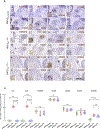Raltegravir blocks the infectivity of red-fluorescent-protein (mCherry)-labeled HIV-1JR-FL in the setting of post-exposure prophylaxis in NOD/SCID/Jak3-/- mice transplanted with human PBMCs
- PMID: 28893602
- PMCID: PMC8057117
- DOI: 10.1016/j.antiviral.2017.09.003
Raltegravir blocks the infectivity of red-fluorescent-protein (mCherry)-labeled HIV-1JR-FL in the setting of post-exposure prophylaxis in NOD/SCID/Jak3-/- mice transplanted with human PBMCs
Abstract
Employing NOD/SCID/Jak3-/- mice transplanted with human PBMCs (hNOJ mice) and replication-competent, red-fluorescent-protein (mCherry; mC)-labeled HIV-1JR-FL (HIVmC), we examined whether early antiretroviral treatment blocked the establishment of HIV-1 infection. The use of hNOJ mice and HIVmC enabled us to visually locate infection foci and to examine the early dynamics of HIVmC infection without using a large amount of antiretroviral unlike in non-human primate models. Although when raltegravir (RAL) administration was begun 1 day after intraperitoneal (ip) inoculation of HIVmC, no plasma p24 or plasma HIV-1-RNA (pRNA) were detected in 10 of 12 hNOJ (hNOJmCRAL+) mice as assessed on the last day of the 14-day continuous twice-daily RAL administration, all 10 untreated hNOJmC (hNOJmCRAL-) mice became positive for p24 and pRNA and had significantly swollen lymph nodes in peritoneal cavity and abundant p24+/mC+/CD3+/CD4+ T cells and p24+/mC+/CD68+ monocytes/macrophages were identified in their omenta and mesenteric lymphoid tissues/lymph nodes upon necropsy of the mice on day 14. In 12 hNOJmCRAL+ mice, no significantly swollen lymph nodes were seen compared to hNOJmCRAL- mice; however, in the omentum of the 2 hNOJmCRAL+ mice that were positive for pRNA and in site RNA, mC+/p24+/CD3+/CD83+ cells were identified, suggesting that viral breakthrough occurred later in the observation period. The present data suggest that the use of hNOJ mouse model and HIVmC may shed light on the study of early-phase dynamics of HIV-1 infection and cellular events in post-exposure/pre-exposure prophylaxis.
Keywords: HIV-1 breakthrough; In vivo imaging; NOD/SCID/Jak3−/− (NOJ) mice; Post-exposure prophylaxis; Raltegravir administration; mCherry-labeled HIV-1 (HIVmC).
Copyright © 2017. Published by Elsevier B.V.
Conflict of interest statement
Conflict of interest
All authors declare no conflict of interest.
Figures






Similar articles
-
Early phase dynamics of traceable mCherry fluorescent protein-carrying HIV-1 infection in human peripheral blood mononuclear cells-transplanted NOD/SCID/Jak3-/- mice.Antiviral Res. 2017 Aug;144:83-92. doi: 10.1016/j.antiviral.2017.03.027. Epub 2017 Apr 7. Antiviral Res. 2017. PMID: 28392419 Free PMC article.
-
Expansion of activated memory CD4+ T cells affects infectivity of CCR5-tropic HIV-1 in humanized NOD/SCID/JAK3null mice.PLoS One. 2013;8(1):e53495. doi: 10.1371/journal.pone.0053495. Epub 2013 Jan 2. PLoS One. 2013. PMID: 23301078 Free PMC article.
-
The pharmacokinetic profile of raltegravir-containing antiretroviral therapy in HIV-infected individuals over 60 years of age.HIV Clin Trials. 2015 Jan-Feb;16(1):39-42. doi: 10.1179/1528433614Z.0000000006. Epub 2015 Jan 14. HIV Clin Trials. 2015. PMID: 25777188
-
Dynamics of HIV-1 DNA level in highly antiretroviral-experienced patients receiving raltegravir-based therapy.Eur J Clin Microbiol Infect Dis. 2012 Feb;31(2):129-33. doi: 10.1007/s10096-011-1284-0. Epub 2011 May 11. Eur J Clin Microbiol Infect Dis. 2012. PMID: 21559766 Clinical Trial.
-
Reduced antiretroviral drug efficacy and concentration in HIV-infected microglia contributes to viral persistence in brain.Retrovirology. 2017 Oct 16;14(1):47. doi: 10.1186/s12977-017-0370-5. Retrovirology. 2017. PMID: 29037245 Free PMC article.
Cited by
-
Patient-derived xenograft models: Current status, challenges, and innovations in cancer research.Genes Dis. 2025 Jan 8;12(5):101520. doi: 10.1016/j.gendis.2025.101520. eCollection 2025 Sep. Genes Dis. 2025. PMID: 40548062 Free PMC article. Review.
References
-
- Dargent JL, Lespagnard L, Kornreich A, Hermans P, Clumeck N, Verhest A, 2000. HIV-associated multinucleated giant cells in lymphoid tissue of the Waldeyer’s ring: a detailed study. Mod. Pathol. 13,1293–1299. - PubMed
-
- Fang G, Weiser B, Visosky A, Moran T, Burger H, 1999. PCR-mediated recombination: a general method applied to construct chimeric infectious molecular clones of plasma-derived HIV-1 RNA. Nat. Med. 5, 239–242. - PubMed
-
- Garcia-Lerma JG, Otten RA, Qari SH, Jackson E, Cong ME, Masciotra S, Luo W, Kim C, Adams DR, Monsour M, Lipscomb J, johnson JA, Delinsky D, Schinazi RF, Janssen R, Folks TM, Heneine W, 2008. Prevention of rectal SHIV transmission in macaques by daily or intermittent prophylaxis with emtricitabine and tenofovir. PLoS Med. 5, e28. - PMC - PubMed
Publication types
MeSH terms
Substances
Grants and funding
LinkOut - more resources
Full Text Sources
Other Literature Sources
Medical
Research Materials

